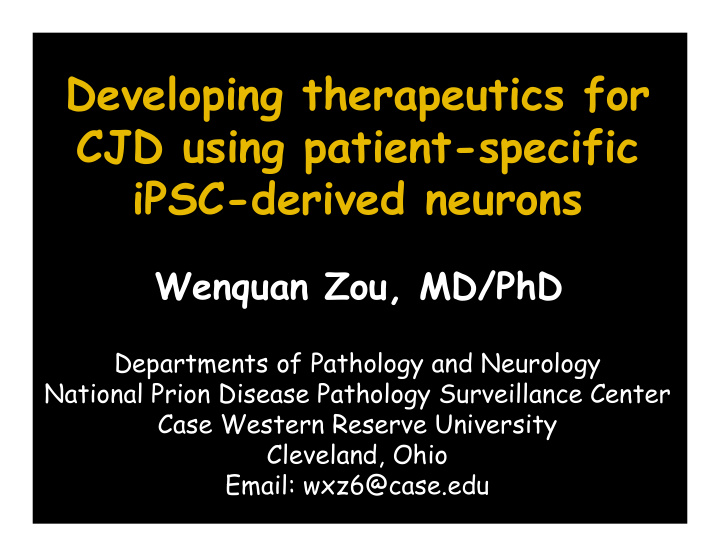



Developing therapeutics for CJD using patient-specific iPSC-derived neurons Wenquan Zou, MD/PhD Departments of Pathology and Neurology National Prion Disease Pathology Surveillance Center Case Western Reserve University Cleveland, Ohio Email: wxz6@case.edu
Code Genotype Asso. Diseases Phenotype 1 E200K (MM) fCJD Carrier 2 D178N (MM) FFI Carrier 3 F198S (MV) GSS Carrier 4 E200K (MM) fCJD Carrier 5 WT (MM) sCJD sCJD 6 5 ‐ Oct ins(VV) CJD Carrier 7 WT (MM) Normal Normal 8 WT (MV) Normal Normal 9 WT (MV) AD AD 10 WT (MM) Normal Normal 11 E200G (MV) fCJD Carrier 12 Del24bp Diabetes Diabetes 13 2 ‐ Oct ins (MM) fCJD Carrier 14 WT (MM) sCJD sCJD 15 WT (MM) Amputation Normal 16 WT (?) Panniculectomy Normal 17 WT (?) sCJD sCJD 18 WT (?) Normal Normal 19 WT (?) Normal Normal 20 WT (?) Normal Normal 21 E200K (MV) fCJD Carrier 22 WT (?) sCJD sCJD 23 D178N (MM) FFI Carrier 24 E200K (MV?) sCJD sCJD
Vulnerability to copper oxidative stress 0 400 µM 800 µM Normal 0 400 µM 800 µM E200K 100 80 Survival (%) LC 50 60 WT ≈ 500 µM 40 E200K ≈ 200 µM 20 0 100 400 800 1100 Cu (µM)
Mitochondria from normal and mutant fibroblasts CTL D178N E200K
Electron microscopy of patient-specific fibroblasts CTL D178N
PrP in patient-specific fibroblasts Fibroblasts Brain Fibroblasts 5 ‐ Insert 2 ‐ Insert D178N E200G E200K E200K F198S sCJD sCJD sCJD APN MD CTL CTL PLY AD 01 02 03 04 05 06 07 08 09 11 12 13 14 15 16 17 kDa * 34 ‐ * ‐ U Untreated * 27 ‐ * ‐ M * * ‐ L ‐ U 27 ‐ +PK ‐ M +PNGase F ‐ L 19 ‐
RT-QuIC analysis of PrP seeding activity with patient-specific fibroblasts (Arbitrary unit, x10 4 ) (Arbitrary unit, x10 4 ) sCJD (BH) 25 sCJD (BH) 22.0 E200G (Fib) Relative THT sCJD (Fib) Relative THT Non ‐ CJD (Fib) 20 17.6 Non ‐ CJD (Fib) 13.2 15 8.8 10 4.4 5 0 10 20 30 40 50 10 20 30 40 50 60 Time (hours) Time (hours)
Immunofluorescent staining of iPSC-derived neurons (WT) with β III tubulin and PrP (Tohoku2) A B β III tubulin (40X) PrP (40X) C D DNA (40X) Merge (40X)
Comparison of iPSC-derived neurons carrying WT and mutant PrP WT E200K D178N
Effect of prion on iPSC- derived neurons untreated prion ‐ treated A B
Summary of previous study ● Fibroblasts have been generated from asymptomatic mutation-carriers, sCJD patients, and controls ● Fibroblasts exhibit some prion-related phenotypes ● iPSC lines and iPSC-derived neurons have been generated from normal controls and two mutations ● Neurodegeneration-like changes were found in mutant and prion-challenged WT iPSC-derived neurons
Aim of new study ● Employ the newly-generated authentic human brain cells to investigate cellular mechanism of the anti-prion activity of the GSK compound, an inhibitor of protein kinase RNA-like ER kinase (PERK) that has been reported to effectively prevent neurodegeneration in prion- infected mice
Purification of PrP Sc from infected human brains
Treatment of infected iPSC- derived neurons with GSK compound A B
Treatment of iPSC-neurons with GSK compound A B
Summary of the current study ● PrP Sc has been purified from infected human brains ● GSK compound may cure prion-induced neurodegeneration in WT iPSC-derived neurons ● GSK compound seems to improve neurodegeneration in iPSC-derived mutant neurons
Acknowledgements Zou Lab Collaborators Jue Yuan Yian Zhan Yu Li Paul Tesar Xin Qi CJD Foundation Byron Caughey Debbie Yobs Christina Orru Florence Kranitz Tingwei Mu Donors Hisashi Fujioka Jeanne Cole Kathy Esposito Shulin Zhang Rhonda Fansler Sue Homer Miguel Quinones-Mateu Janine Kock Keith Welch Brian Appleby Deborah Wilson Robert Wyza Participants Mark Rodgers Funding Tetsuyuki Kitamoto CJD Foundation and NIH Dermatologists
Conclusions Our study suggests the therapeutic effect of GSK compound on prion- infected or mutant iPSC-derived human neurons, which is consistent with previous observations by other groups with animal models
Recommend
More recommend